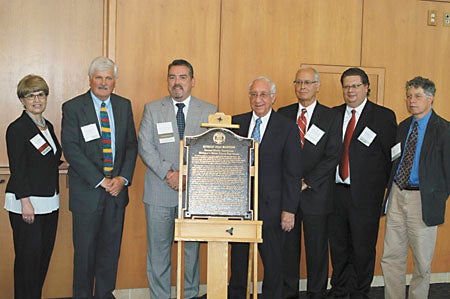State Bar in Berrien for oldest courthouse marker
Published 9:15 pm Wednesday, June 26, 2013

State Bar of Michigan Executive Director Janet Welch, Berrien County Chief Judge Thomas Nelson, State Bar President Bruce Courtade, retired Berrien County chief judge and former State Bar president Alfred Butzbaugh, Conybeare Law Office attorney Michael Marrs, Michigan Assistant Attorney General John Fedynsky, who wrote a book chronicling all 83 courthouses, and Robert Myers, curator of the History Center at Courthouse Square, as the 1839 courthouse complex in Berrien Springs is known today. Lapeer’s is second-oldest.
BERRIEN SPRINGS — An 1894 election cost this community the Berrien County seat to St. Joseph, but its 1839 Greek Revival courthouse survives to rank as Michigan’s oldest county courthouse.
The 42,600-member State Bar of Michigan on Wednesday at Howard Performing Arts Center at Andrews University recognized that fact by unveiling a bronze plaque designating it the 38th Michigan Legal Milestone in a ceremony attended by 80 that involved 78th President Bruce Courtade of Grand Rapids, past president Alfred Butzbaugh, retired Berrien County chief judge, and current Chief Judge Thomas Nelson.
The 30th marker, Cass County’s Freedom Road, recognizing the Underground Railroad, was announced in August 2005 at Southwestern Michigan College in Dowagiac and placed outside the 1899 courthouse in Cassopolis.
Architecturally representative of the type of buildings used by Michigan’s earliest judges and lawyers, architect Gilbert B. Avery designed the courthouse local builder James Lewis constructed beginning in 1838 to finish in time for the April 1839 court term, when judges literally traveled circuits.
It is similar in appearance to the Virginia Capitol designed by Thomas Jefferson, which a March book, “Ten Buildings That Changed America,” ranked No. 1.
The courthouse consisted of the main floor courtroom and lower-level offices for county officials.
As much a community gathering-place as a court building, it accommodated political party conventions, temperance lectures, musicals, theatrical performances, civic meetings, religious services, weddings and funerals.
During the Civil War, county residents conducted fundraising rallies for soldiers’ families on the courthouse grounds.
Structural problems led to a major renovation in 1863 which “jacked up” the courthouse three feet to install a brick lower floor, along with a second-floor balcony, boxes under columns and two new interior staircases.
Voting in 1894 shifted the seat of county power back to St. Joseph ostensibly because Berrien Springs lacked railroad service.
Berrien County, named for John Berrien, attorney general in the Andrew Jackson administration and one of the “cabinet county” namesakes along with Van Buren and Cass, sold the 1839 courthouse.
Between 1894 and 1966, it served as a dance hall, militia drill hall, a Seventh-day Adventist Church in 1917 and the first home for Emmanuel Missionary College (today’s Andrews University).
Jackson signed legislation making Michigan the 26th state in 1837.
Berrien County Historical Association acquired the courthouse in 1967 and began a seven-year restoration.
Michigan redesignated it an active court for ceremonial purposes in 1974. Retired Judge John Fields, who made it accessible to students, attended the ceremony.
It is listed on the National Register of Historic Places after almost being reduced to a parking lot at one point.
Robert Myers, curator of The History Center at Courthouse Square, is the author of nine books, including Historical Sketches of Berrien County, Locomotives Along the Lakeshore and three volumes of Greetings (from Berrien Springs, St. Joseph and Benton Harbor).
Myers, president of The Historical Society of Michigan and active with Fort St. Joseph archaeology in Niles, said the first county seat, placed by the territorial legislature in 1832, was in St. Joseph. The state legislature moved it to Berrien Springs in 1837. The first county building, in 1838, was a jail.
“It is in the geographic center of the county, making it inconvenient for everyone to get here,” Myers said. “The bitterly contested election to move the county seat carried by 242 votes out of almost 11,000 cast. The Berrien Springs editor wrote, ‘The motive power used in the (records) removal was mostly furnished by horses, but the direction of affairs was left to jackasses, of which St. Joseph has an abundance.’ They were a little bitter.”
Also attending were Judges Mabel Johnson Mayfield and Sterling Schrock, Prosecutor Art Cotter, retired judge Casper Grathwohl of Niles, former prosecutor John Smietanka and County Commissioner Mamie Yarbrough.
“Courthouses symbolized law and order and the progression from wilderness to civilization,” according to Michigan Assistant Attorney General John Fedynsky, author of a book chronicling all 83 county courthouses. “In courthouses like this one, across the state, the bedrock for Michigan jurisprudence was born. In the history of this county, Niles, Benton Harbor, St. Joseph and Berrien Springs vied for the county seat because fortune and sacred honor rode on who got it. It’s where land transactions get recorded, hotels and railroads get built and lawyers and judges settle. It involves a lot of commerce and personal pride so there was a lot of maneuvering. My book tells about the parade of 39 ox carts that took all the records from Berrien Springs over to the new county seat in the late 1890s. When it moved to Berrien Springs, it took two. There were hurt feelings in one town, happy feelings in the other. Courthouses stand at the center of the community at large — not just the legal community.”
“The State Bar of Michigan has been placing historical markers around the state for the past 27 years,” Executive Director Janet Welch said. “They tell the stories of events, places and individuals who shaped our history and our law,” including President Gerald R. Ford. “We hope we bring history to life for the public to show the reach, dimensions, complexity and importance of the rule of law.”






